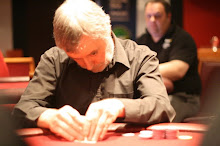"NO LIMIT STRATEGY"
Neteller: Last week $150; Current $150 (-)
Inter: Last week $27; Current; $27 (-)
William Hill: Last week $119; Current $129 (+10)
Ladbrokes: Last week $104; Current $151 (+47)
Bodog: Last week $103; Current: $83 (-20)
Total: Last week $495; Current $532 (+37)
Winnings for the month come in at $225, which is a little bit more than last month.
Regular readers may possibly be wondering how someone with a total inability to make a go of No Limit Holdem up until recently, has suddenly developed a winning game, all be it at a very modest level. A great deal of the credit should go to a site I discovered when I was researching how to play No Limit, called "freeholdemstrategy.com".
On this site they advocate a "tight/passive" strategy for No Limit holdem games with a buy in of below $200. Basically, because of the high number of poor players who see too many flops at this level, you can afford to play a very conservative game, seeing about 20% of flops and waiting for a really big hand on the flop that will give you a chance to double up by getting someone all in. It is certainly a very easy strategy to learn and it has been working for me effectively enough.
In fact it has been so effective that I have begun to tweak it a little bit, by trying some limping with AK in early position and other slightly non-standard moves. I've been doing this from time to time to "mix up my game" and not become too predicatable. So long as I bear in mind (as I have been doing) the fundamental principle that if I've anything less than a set after the flop I'm very vulnerable, I shouldn't come to too much harm. I've also tended to be fairly aggressive with top pair/top kicker if I hit it - though still folding if I meet resistance as advised.
The positive thing about this strategy is that it contradicts a lot of the "conventional wisdom" about playing No Limit that you read about in books - i.e. the "tight/aggressive" approach. I think it is often very useful to apply a "contrary" approach to that generally seen; in the same way that it is best to play a rather looser game at a tight table and a tight game at a loose table.
It's working for me anyway.



1 comment:
Hey Kronsdat,
This is a very interesting post. I too have been trying a tight-passive strategy over the last couple of weeks, and the results seem good so far.
When I'm ahead, or have a draw, I'll usually bet half the pot for value. I've been trying to avoid betting the pot, as this builds pots that are hard to get away from, even though I know I'll be outdrawn.
Regards,
The Edge.
Post a Comment